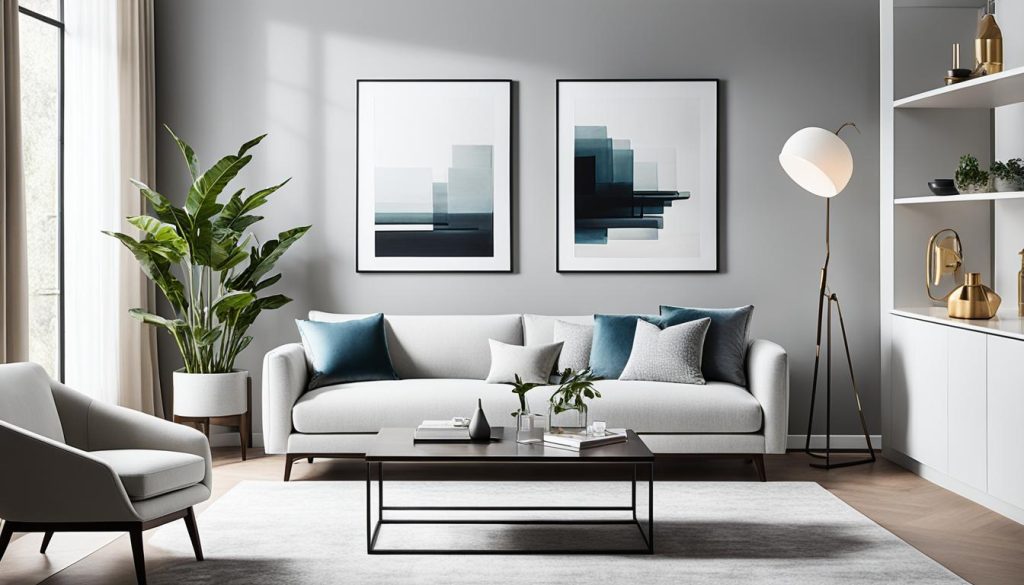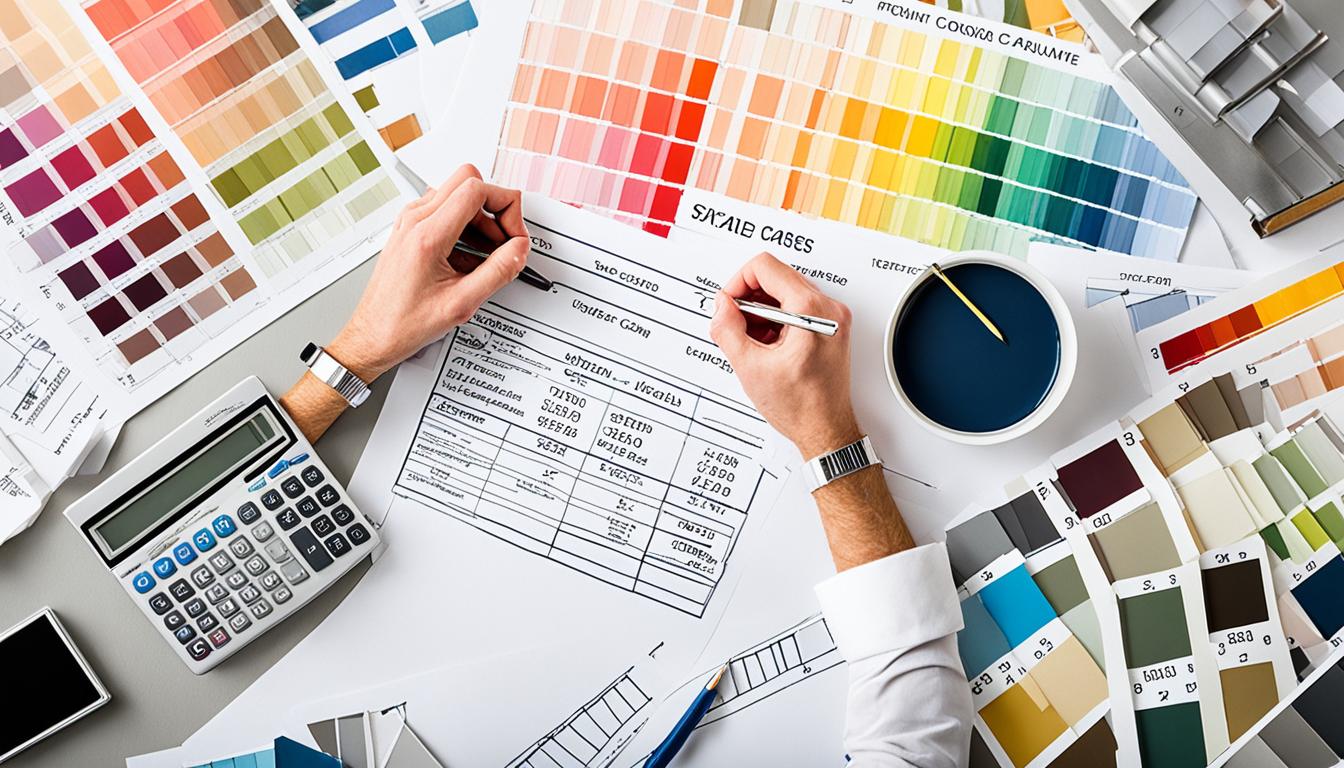Did you know that interior designers have the flexibility to choose their own pricing strategies? There is no regulatory body setting a standard price for their services. This means that designers must have a clear and transparent pricing strategy to effectively communicate with clients and ensure a successful business.
When it comes to pricing interior design services, there are various models that designers can consider. Each model has its pros and cons, and it is important for designers to choose the one that aligns with their business goals and caters to their target market.
Key Takeaways:
- Interior designers have the freedom to choose their own pricing strategies.
- Having a clear and transparent pricing strategy is essential for effective communication with clients.
- Pricing models such as hourly fees, flat fees, cost-plus pricing, square footage contracts, and percentage fees can be considered.
- Each pricing model has its advantages and disadvantages; designers should select the one that aligns with their business goals.
- The chosen pricing strategy should cater to the target market and ensure a profitable business.
Hourly Fees
When it comes to pricing strategies for interior design services, many designers opt for charging hourly fees. This method allows designers to bill clients based on the number of hours spent on a project, providing a transparent breakdown of costs. However, it requires careful time tracking and accurate calculation of project expenses to ensure fair and profitable pricing.
When determining the hourly rate, it is crucial for designers to consider all expenses associated with the project. This includes lease, advertising, supplies, salaries, and other overhead costs. By factoring in these expenses, designers can ensure that their hourly rate covers not only their time but also the operational costs of running their business.
In addition to covering expenses, it’s important for designers to factor in a profit margin when setting their hourly rate. This margin ensures that designers can generate revenue beyond their costs, supporting the growth and sustainability of their business. By charging an appropriate hourly rate, designers can earn a fair income while delivering high-quality design services.
However, it’s worth noting that charging hourly fees may not be suitable for all situations. Beginners or designers with uncertain time requirements for a project may find it challenging to accurately estimate the final cost. Additionally, clients may prefer alternative pricing models that offer more certainty in terms of budgeting and project costs.
Overall, hourly fees can provide designers with flexibility and transparency in pricing their services. By accurately calculating project costs and considering all expenses, designers can ensure that their hourly rate reflects the value they provide to clients while maintaining a profitable business model.
Comparison Table: Hourly Fees vs. Flat Rate Pricing
| Hourly Fees | Flat Rate Pricing |
|---|---|
| Charged based on the number of hours spent on a project | Provides clients with a fixed price for the entire project |
| Requires accurate time tracking and expense calculation | Allows for easy budgeting and cost transparency for clients |
| Offers flexibility in pricing for projects with uncertain time requirements | Provides clients with certainty in project costs |
| Enables designers to cover both their time and operational costs | Requires designers to factor in buffers or contingency reserves for unexpected expenses |
Flat Fees
Flat fees, also known as design fees or fixed rates, are a popular pricing strategy for interior designers. With this method, I provide clients with a fixed price for the entire project, without breaking down the costs or hours involved. This approach offers transparency to clients, allowing them to budget for their project upfront.
When setting flat fees, it is important to consider various factors to ensure competitive pricing that aligns with the value of my design services. I assess the scope of the project, the level of complexity, and the estimated time required for completion. By understanding the project requirements, I can accurately determine a fair and reasonable flat fee.
It is essential to account for unexpected expenses or changes that may arise during the project. To mitigate potential financial risks, I include buffers or contingency reserves in the overall cost. This ensures that I can accommodate any unforeseen circumstances without incurring losses.

| Advantages of Flat Fees | Challenges of Flat Fees |
|---|---|
|
|
By offering flat fees, I provide my clients with a comprehensive pricing structure that eliminates any confusion or ambiguity regarding charges. This fosters trust and confidence, ensuring a positive client experience.
Cost-Plus Pricing
When it comes to estimating interior design costs and negotiating design fees, cost-plus pricing is a straightforward approach that ensures both designers and clients are on the same page. With cost-plus pricing, designers inform clients of the fee, which includes all project costs along with an additional markup. This method guarantees that designers are compensated fairly for both their time and expenses.
One of the benefits of cost-plus pricing is its transparency. By clearly communicating the cost elements and the percentage of markup to clients, designers can avoid any misunderstandings and build trust. Clients appreciate knowing exactly what they are paying for and how their money is being allocated.
Clients also find value in the clutter-free billing process that cost-plus pricing offers. Instead of receiving separate invoices for different expenses, they receive a consolidated bill that includes everything. This allows for better budgeting and easier tracking of project costs.
Designers, on the other hand, benefit from cost-plus pricing by ensuring they receive fair compensation for their work. By including all project costs in their fee calculation, designers can accurately estimate their expenses and ensure that they are adequately covered. This approach also allows designers to account for any unforeseen expenses that may arise during the project.

Square Footage Contracts
One popular pricing model for interior designers is square footage contracts. With this approach, designers charge clients based on the total square footage of the project. To determine the price per square foot, designers estimate the total costs, add a markup, and divide the amount by the square footage. This method is commonly used in high-end commercial projects, where the size of the space directly correlates with the overall cost.
Implementing square footage pricing requires accurate cost estimation and the inclusion of a contingency reserve. Designers must carefully anticipate the costs associated with materials, labor, and other project expenses. By providing clients with a clear understanding of the costs involved based on the size of the project, square footage contracts offer transparency and help clients budget effectively.
However, designers must ensure that their estimations are accurate to avoid undercharging or overcharging clients. A detailed breakdown of the costs involved in the square footage pricing model can help establish trust and credibility with clients.
| Pros | Cons |
|---|---|
| Transparency for clients | Requires accurate cost estimation |
| Effective for high-end commercial projects | May not be suitable for projects with uncertain square footage |
| Helps clients budget effectively | Does not account for design complexity |
Percentage Fees
If you’re an interior designer working on projects that are expected to span a long period of time, implementing a percentage fee structure may be a suitable pricing strategy for your design services. With this approach, you can determine a percentage of the total project budget as your fee, typically up to 30%. This pricing model ensures that you receive recurring revenue throughout the duration of the project, providing stability and cash flow for your business.
When implementing percentage fees, it’s crucial to develop a comprehensive budget for each project. This involves calculating the estimated costs and determining an appropriate percentage structure that aligns with your business goals. Factors such as project duration and potential customer lifetime value should also be considered to accurately assess the appropriate percentage fee. By carefully analyzing these factors, you can ensure that your pricing is fair for both you and your clients.
By utilizing a percentage fee structure, you can establish a mutually beneficial relationship with your clients, while also securing a steady income stream. This pricing model allows for flexibility and transparency, as the fee is directly tied to the project budget. As an interior designer, it’s important to have a clear and transparent pricing strategy that effectively communicates the value you provide to your clients. Implementing percentage fees can be an effective way to achieve this, while also ensuring that you are compensated fairly for your expertise and services.
